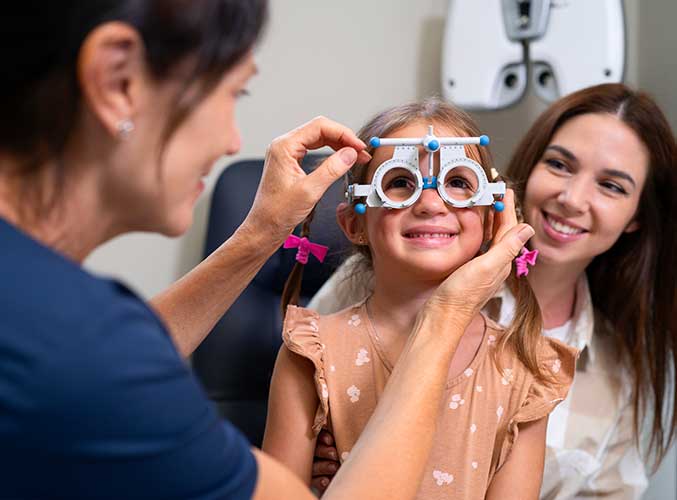Visual Therapy and Clinical Optometry
Improve your visual performance and correct dysfunctions with personalized visual therapy.
At Somat Clinic, we take vision care one step further with our Visual Therapy and Clinical Optometry service, based on the discipline of behavioral optometry, which studies how the eyes, brain, and body work together to interpret the world around us.
We have the technical and human resources necessary to ensure that each patient not only achieves good visual acuity, but also develops and enhances the visual skills needed for more effective performance in daily life: at school, work, sports, or recreational activities. Our mission goes beyond prescribing glasses; we seek to understand how the visual system relates to learning, development, posture, and performance, in order to offer a comprehensive approach that supports the individual in all their activities.
With the aim of applying the Developmental Optometry, Visual Therapy, and Rehabilitation model, the assessments carried out are personalized and adapted to the visual health and age of each patient (babies, children, and adults). The purpose of these evaluations is to analyze visual efficiency (eye movements, focusing, three-dimensional vision, eye coordination, visual acuity, refractive status, etc.) and visual perception—that is, how the brain interprets the information it receives through the eyes (visual memory, visual discrimination, figure-ground perception, shape constancy, visual closure, spatial relations, visuomotor integration, visuo-auditory integration, etc.).
What is Vision Therapy?
There are certain visual conditions that cannot be properly corrected with glasses or contact lenses alone, but that can be addressed through a Vision Therapy program.
Behavioral vision therapy is an optometric and neurofunctional treatment, fully personalized, that aims to correct and strengthen dysfunctions of the visual system that are not of pathological origin.
It consists of a series of exercises and activities specifically designed according to each patient’s needs, with the purpose of training and improving visual skills. In this way, the visual system functions more efficiently, leading to better performance in everyday, academic, work, sports, or recreational activities. This treatment is suitable for both children and adults.

How is Vision Therapy carried out?
Based on the results obtained from the evaluation of visual information processing (visual efficiency and visual perception), and taking into account each patient’s academic, professional, sports, or recreational needs, the optometrist designs a personalized Vision Therapy program. The goal is to develop and maximize visual skills and their integration with other senses, such as hearing or balance.
The program includes weekly in-office sessions, where the therapist guides the patient through different activities, along with daily home exercises, which are essential to consolidate progress. This process helps the brain establish new connections and strengthen existing ones, bringing about a positive change in how the patient uses their visual skills. Automating and integrating these changes is key for the person to incorporate them effortlessly into daily life with lasting results.
Vision Therapy is always carried out in a dynamic way, adapting to each person’s age and needs. The therapist uses a wide variety of tools, materials, and games that make every activity motivating and engaging.
How do I know if I would benefit from Vision Therapy?
Neuroplasticity is present throughout life, which is why Behavioral Vision Therapy can benefit people of all ages—from children to adults—helping to improve visual efficiency and processing at any stage.
-
Babies and preschool children:
-
To stimulate and support visual development from the very first months of life.
-
In cases where a delay in visual developmental milestones is suspected.
School-age children, adolescents, and adults:
-
-
Amblyopia.
-
Double vision.
-
Difficulties with reading, writing, or reading comprehension.
-
Skipping lines while reading.
-
Difficulty maintaining prolonged reading.
-
Difficulty remembering what has been read.
-
Attention and concentration problems related to vision.
-
Headaches.
-
Visual fatigue.
-
Slow changes in focus from near to far (difficulty copying from the board or taking notes).
-
Covering or squinting one eye while reading.
-
-
-
Tilting the head while reading.
-
Visual stress from long hours of studying or intensive screen use.
-
Low academic performance that may be associated with functional vision problems.
-
Difficulty with writing.
-
Misjudging distances.
-
Difficulty going up or down stairs.
-
Dizziness when in motion (car, bicycle, etc.).
-
Feeling that the surrounding world is unstable.
-
Athletes seeking to improve coordination, accuracy, and reaction times.
-
Symptoms of visual fatigue at work (computer, office, prolonged reading).
-
People who, after a neurological injury (trauma, stroke, etc.), require visual rehabilitation.
Any questions? Write to us!
We will be happy to help you with any questions about our services or your treatment.
